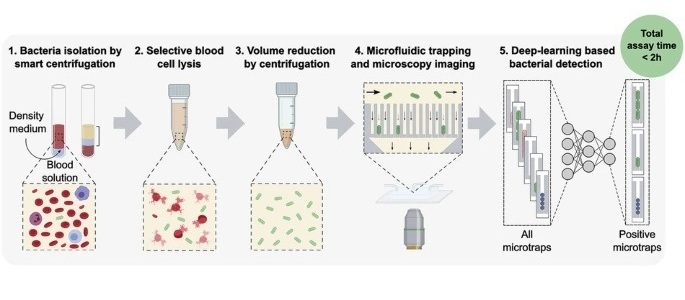New Diagnostic Method Confirms Sepsis Infections Earlier
Posted on 01 Sep 2025
Sepsis remains one of the most dangerous medical emergencies, often progressing rapidly and becoming fatal without timely intervention. Each hour of delayed treatment in septic shock reduces patient survival by nearly 8 percent. Current diagnostic methods depend on bacterial culture, which requires at least a day to detect infections and two to four days to confirm the right antibiotic treatment. Now, a new diagnostic approach for sepsis offers a way to cut this critical time drastically.
Researchers at KTH Royal Institute of Technology (Stockholm, Sweden), in collaboration with Uppsala University (Uppsala, Sweden), have developed a diagnostic method that uses a centrifuge and automated microscopy combined with artificial intelligence (AI). Their system separates bacteria from blood cells using a “smart centrifugation” process and then captures the bacteria in microscale chip channels. The clear liquid layer containing bacteria is analyzed through time-lapse microscopy, with AI software trained to confirm infection in as little as two hours.

The new method was evaluated using blood samples spiked with clinically relevant bacteria. It successfully detected E. coli, K. pneumoniae, and E. faecalis at levels as low as 7–32 colony-forming units per milliliter of blood. However, the findings, published in npj Digital Medicine, showed it was less effective for Staphylococcus aureus, which tends to hide in blood clots, a limitation the researchers are working to overcome.
This advance could allow doctors to start targeted antibiotic treatment much sooner than with traditional culture. Faster diagnosis reduces the need for broad-spectrum antibiotics, which carry risks of toxicity, disruption of gut microbiota, and rising antimicrobial resistance. By confirming bacterial infections within hours rather than days, the method offers safer and more effective treatment pathways.
Future work will focus on adapting the system to detect a wider range of bacteria, improving performance for pathogens such as Staphylococcus aureus, and preparing for clinical validation. The technology’s combination of speed, sensitivity, and automation positions it as a valuable tool for hospitals worldwide in managing sepsis cases.
“It takes a hospital two to four days before they are sure which antibiotic to treat a bloodstream infection with,” said Wouter van der Wijngaart, a professor at KTH Royal Institute of Technology who leads research in microfluidic and biomedical systems. “We’re trying to do this in four to six hours.”
Related Links:
KTH Royal Institute of Technology
Uppsala University













